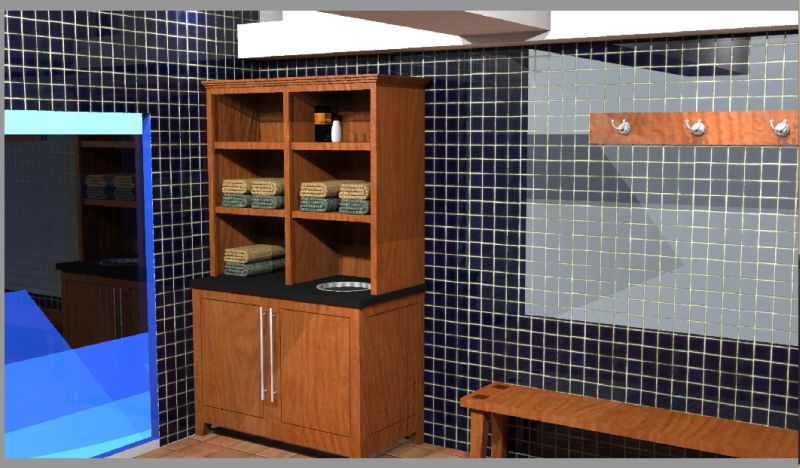Finishing a Wood Cabinet in a Shower Area
A commercial job in a wet area calls for extra-special care. December 6, 2011
Question
I am building some furniture which will be built in to a shower area/changing room. The cabinet in the image below has a stainless grommet through which you throw your used and wet towels that a janitor will empty every night. This is a commercial application and though I think CV is the way to go. I have heard you can't touch up CV like lacquer. It will get damaged in time and I am sure they will want me to touch up.

Click here for higher quality, full size image
Forum Responses
(Finishing Forum)
From contributor Z:
This is promising to be an epic failure. Bathroom areas such as this are going to destroy this furniture the minute you install it. I would personally shoot for something in a laminate form, and coming from me, I hate laminate. The only thing I hate more is for someone in my trade to get it in the shorts because of a lack of experience.
From contributor C:
Hi chris, I agree with Contributor Z's suggestion. Since you only listed Conversion Varnish and a Pre-Cat as your finish choice I think that the finish would surely begin to fail soon after you installed it in that type of environment. From your picture it looks like you could get a plastic laminate that would easily match what the finish indicates on your picture. The only part you probably wonít be able to replicate in a P-Lam would be the crown. Research other types of finishes for coating the crown. Maybe a two part poly or an auto coating would work but to use a CV or a Pre-cat on the entire project, I think you would be getting yourself in a jam.
From contributor U:
In regards to the crown, go to any big cabinet door company web-site and look up thermo-foil doors (RTF). They have crown mouldings that match their doors. The RTF skins match many popular laminates so you can make laminate slab doors and have matching crown. The RTF should withstand the moisture problem for years.
From the original questioner:
Thermofoil - can't do it. Itís supposed to look a bit like a "Gentlemenís Club", thatís my take. After talking to a new finisher itís become apparent that an automotive finish is what this calls for. The wood is sapele solid and crossband ply by the way.
From contributor B:
I've used Pettit marine varnish for a shower/bathroom project that had mahogany throughout. It even had mahogany trim inside an open shower stall going around the stall and under the shower head ! I sprayed six coats of their 2015 flagship varnish. It's still looks great and is holding up well after five years.
From contributor B:
One more thing. In that environment you'll need a flexible finish such as the marine varnish I mentioned. CV is a very hard finish once it cures. With all the moisture/dampness your wood will move and the CV will crack and fail.
From contributor X:
Once you decide on a finish make sure you coat every bit of the cabinet as possible, not just the faces that show. I would try to pre-finish as many parts as possible just to get as much of it sealed up as possible. I would even laminate the bottom edge of the cabinet where it sets on the floor. It won't hurt.
From the original questioner:
I just got back from visiting g the jobsite and they are finally done with the sheetrock and now the tile goes in. Turns out they got some industrial ventilation fans which will help. I will seal as mentioned also.
From contributor R:
I would get that cabinet as far off the floor as possible. Stainless leg tips, or stainless levelers. That floor will get wet at the least, and daily moppings at the most. Having a cleaning crew, wet mop swinging around, will be a disaster. Try to get a warranty waiver in the contract somewhere based on adverse conditions and cleaning crew damage.
From contributor K:
I also cringed at first, especially when moisture and finishes are in the mix. I always try and find the weak link and in this case it will lay in your choice of veneer glue to be used. Use a good quality moisture resistant veneer or laminate glue first and foremost. I would consider using a penetrating moisture resistant stain/sealer that in theory hardens the woods fibers rather than just coating them.
